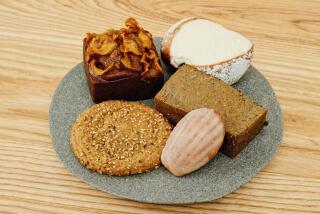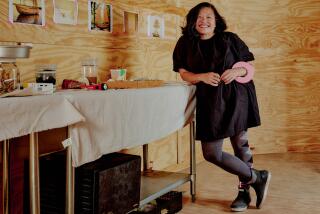Variety is the Tang of Life
- Share via
Sitting in his sleek Melrose Avenue restaurant, Tommy Tang piles pieces of curried chicken, meekrob noodles and sprigs of fresh mint onto a bed of romaine lettuce, rolls it and dips it into a vinaigrette sauce.
“If you eat Thai food every day, you automatically lose weight,” says the chef and restaurateur in between bites. “I can eat like a pig and never gain weight.”
As colorful as his signature bandannas and Hawaiian shirts, Tang, 47, is riding a tidal wave of interest in healthy cooking and ethnic foods. With fast-food outlets and frozen entrees in the works as well as a new cookbook and cooking show, Tang is on a mission to make satay as American as pizza and tacos.
“Marketers are looking for [ethnic] products with broad-based appeal,” says Bob Messenger, editor of Food Processing, an industry publication in Chicago.
“Thai food fits right into this . . . and Tommy Tang is touching all the hot buttons. Health and nutrition are clearly No. 1 among all trends.”
Though retail sales of Thai food are small relative to Chinese or Japanese products, its healthful image has propelled it into the fastest-growing segment of the $1-billion-plus Asian food category, with annual growth of about 25%.
Tang hopes to capitalize on this popularity with a new chain of fast-food restaurants. With the backing of a private investor from South Africa, he’s searching for two or three locations on the Westside and Santa Monica.
“A lot of people don’t have much time,” says Tang, a resident of Los Angeles. “We want to do quality food more affordably; lunch and dinner for about $7.”
If the concept catches on, Tang plans to expand throughout California and then go national. Though there are regional Asian fast-food chains, none has succeeded nationwide.
“It’s still an opportunity in food service that no one’s been able to seize on a national level,” says Paul Frumkin, managing editor of Nation’s Restaurant News, a weekly trade journal. “Americans love Oriental food, and the chain that can get consistency under control has got the pot at the end of the rainbow.”
That’s exactly the kind of challenge Tang savors. A willingness to gamble combined with hard work and determination characterize his successful career to date.
Born and raised in Bangkok, the eldest of 10 children, Tang left school at 11 to help support his family. He immigrated to Southern California in 1972, and in the late 1970s landed a job at a little-known Thai restaurant in Los Angeles called Chan Dara. After working his way up to executive chef, Tang turned the failing eatery into one of L.A.’s hot spots and established his own culinary reputation.
With his wife, Sandi, Tang opened his own restaurant on Melrose Avenue in West Hollywood in 1982. He continued to develop his trademark fusion cuisine, combining traditional Thai and Western ingredients to create dishes such as Thai Risotto, and Duck and Arugula Salad. Tang opened his second restaurant in Manhattan in 1986--since closed after losing its lease--and a third restaurant in Pasadena in 1994.
Though he declined to reveal sales, he said his restaurants account for two-thirds of sales; retail products and personal appearances another third.
When Tang started 15 years ago, most Americans outside Los Angeles would not have been able to name a single Thai dish. Thai food was rarely reproduced in American homes because the ingredients were not widely available. That’s all changed.
Today, most U.S. cities have at least one Thai restaurant. Los Angeles, which has the largest concentration of Thais outside Thailand, has 400.
In 1988, Tang introduced a line of Thai sauces and spices, now carried by specialty stores such as Trader Joe’s and Bristol Farms, and supermarkets nationwide, including Albertsons, Vons and Ralphs.
“We noticed people wanting to take home quarts of our peanut sauce and caterers ordering a couple hundred pieces of chicken satay--ungrilled,” Tang says. “So we asked ourselves, why don’t we put these sauces in jars and sell them in cases?”
The majority of Tommy Tang’s products are manufactured in Thailand, the source of raw materials such as fish sauce, coconut milk and chili paste.
About 40% of the seasoning and sauce line, including a popular peanut sauce, are packaged by a Huntington Beach company.
“This is like Shake ‘n Bake; you don’t have to think,” says Tang of his bottled jasmine rice and fried rice sauce. “If you’re a lousy cook, you put our fish sauce on it and it tastes good.”
Tang used his restaurants’ national notice as a springboard to host a public television cooking show, “Tommy Tang’s Modern Thai Cuisine,” which airs in Los Angeles on Saturdays at 11:30 a.m on Channel 28. The show’s goal is to demonstrate that Thai food is healthy and easy to prepare and to dispel the notion that it has to be hot.
To film the show’s second series, Tang travels to Thailand this month in search of local specialties.--from regional fare of the northern hill tribes and fruit plantations of the Eastern seaboard to shrimp farms of the South. To Tang, enjoying Bangkok’s night life means combing food stalls for the tastiest noodles.
“When we greet people in Thailand, we ask, ‘Have you eaten?’ ” he says. “We are a country that likes to share. Food is part of our celebrations.”
More to Read
Eat your way across L.A.
Get our weekly Tasting Notes newsletter for reviews, news and more.
You may occasionally receive promotional content from the Los Angeles Times.










